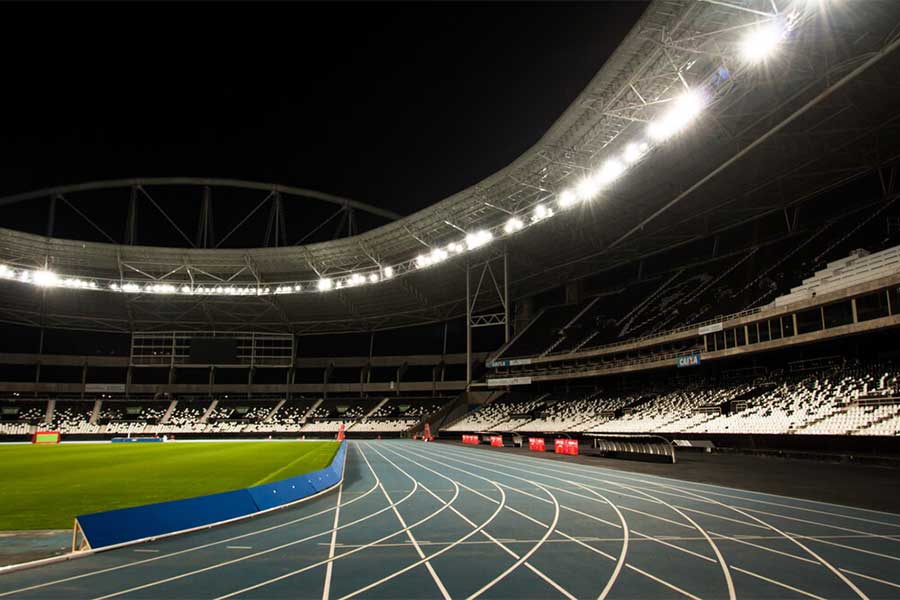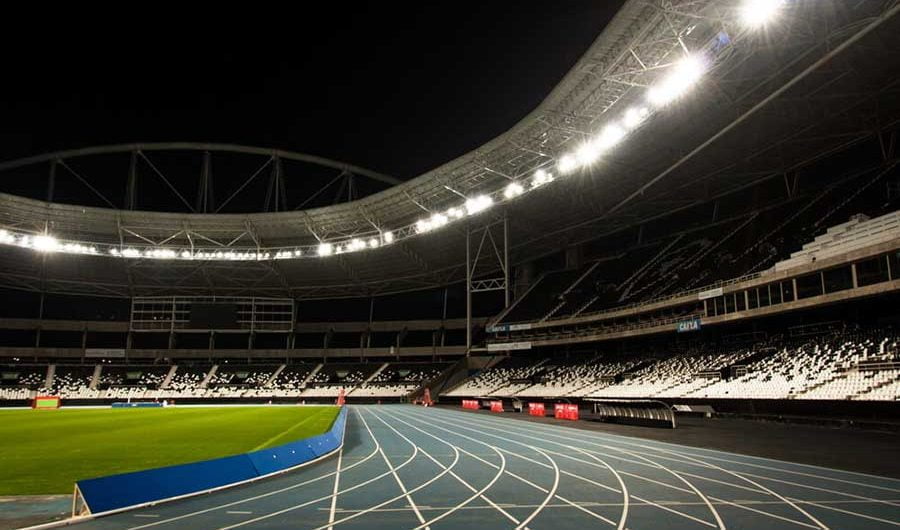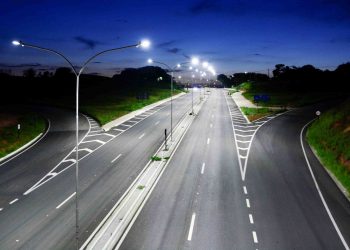
What is the importance of lighting in stadiums and sports courts? Find out here!
Lighting in stadiums and sports courts is an important element in human constructions for holding games, festivals, and even for leisure and recreation. In this context, there is a lot of information on lighting for small spaces such as shops and industries, but there is still little material regarding the topic in sports arenas, for example.
Therefore, we will talk about lighting in stadiums and sports courts, as well as LED reflectors for multi-sport courts and other sports-dedicated environments. In addition, we will provide tips for choosing the best equipment and provide details on evaluating the objectives of lighting, the necessary amount, power, color temperature, glare index, presence sensor, etc.
Want to know how the subject relates to safety, comfort, good visibility, and the public’s experience in these places? Check out this content!
What is the importance of good lighting for stadiums, arenas, and multi-sport courts?
Good lighting for a sports arena should not be seen as an expense, but rather as an investment that has the power to increase profit, save on energy bills, increase demand for space rentals or even host events such as shows.
This is because good lighting benefits both those inside the court or stadium and those watching. It also becomes indispensable for promoting other events. When well-executed, there is greater luminous efficiency and lower energy consumption.
What are the advantages of good lighting in sports arenas?
Now, let’s point out some advantages that good lighting offers for sports courts, arenas, and stadiums. It is important to note that these advantages only appear satisfactorily when the lighting project is well-designed and well-executed.
Safety
Safety is one of the most debated issues in sports stadiums and arenas today. Much thought is given to alternatives on how to reduce violence in these spaces, however, simple measures can also help solve the problem.
This happens for the same reason that poorly lit streets are more dangerous. With this, crimes occur more frequently when the aggressor is certain that they cannot be identified or caught — and a dark or shadowy environment is conducive to this.
Therefore, it is correct to say that good lighting not only increases comfort but also the feeling of security for spectators. The hiring of professionals and surveillance cameras are other good solutions, but they must be adopted in conjunction with good lighting infrastructure.
Comfort
Brightness also generates comfort, both for those in the stands and for those inside the stadium or court, playing or participating in any other event. Lighting allows for good work to be done and for playing under suitable visibility conditions for those inside the environment.
For those in the stands, watching, good lighting allows the person to observe the entire field clearly and identify everything that is happening in the event, whether it is sports-related or not.
Achieving luminous comfort is not easy and, for this, it is necessary to rely on the experience of qualified companies. Unfortunately, poorly executed projects can cause glare for both those in the audience and those on the field. This should be avoided as much as possible, as it harms the entire event audience.
Good visibility
There are several strategies to achieve good visibility for spectators, ranging from the allocation of the stands to the unevenness between one seating level and another. However, lighting is an essential part of this process and must illuminate the entire space.
Randomly placing luminaires does not guarantee good visibility, as some areas may run the risk of being too bright while others are poorly lit. An equal distribution of lighting throughout the stands and the stadium is necessary,
Good experience for the public
All other advantages pointed out are directly linked to the last one. When there is safety, comfort, and good visibility, the public will have a good experience with the event.
What are the necessary precautions for lighting installation?
The two main tips are: choose the appropriate location for installation and opt for suitable luminaires for demand. Incorrect equipment runs the risk of not illuminating the environment neutrally, contributing to confusion, as well as harming good visibility.
Incorrect allocation of lighting poles and floodlights can obscure both the players on the field and the public – a major problem for the show as a whole. Thus, one should aim to achieve an adequate level of brightness for each activity in the stadium.
There are several ways to use light in a sports arena, such as emergency exit lighting, scenic lighting, and facade lighting. Thus, when well planned, the technique enhances the stadium and ensures savings on the energy bill.
Is it worth hiring a company to set up lighting in a sports arena?
Due to the complexity of LED floodlight installation for sports courts, stadiums, or arenas, hiring qualified professionals is highly recommended for the energy system to function correctly. Thus, it will be possible to give the location all the benefits that a good lighting project can provide.
Otherwise, you will be running a serious risk of lighting problems and not fulfilling your role, devaluing the environment, and increasing energy costs.
Another tip is to keep an eye on new LED luminaire technologies, which are a good alternative for lighting and offer good cost-benefit. This option is so viable that the demand for LED has been growing more and more in Brazil. Consider using a project entirely based on this technology, and energy bill savings can reach 80%.
In this way, lighting in stadiums is an important element that must be prioritized. When well planned, it brings numerous benefits and raises the sports arena to another level — and this also influences the profits of the enterprise.
What are the consequences of not having good lighting in stadiums and sports courts?
Many people work during the day and practice sports at night to relieve stress and engage in physical activities periodically. Therefore, it is important to consider the lighting of sports courts as a relevant factor for users.
The lack of luminosity generates insecurity for people who frequent the location due to poor visibility. In addition, regulatory standard NBR 8995-1:2013, from the Brazilian Association of Technical Standards (ABNT), must not be violated.
Non-compliance with legal requirements can bring unpleasant consequences for court owners, in case they are private property. The use of outdated equipment also generates more expenses with constant replacements and maintenance.
What are the relevant tips for choosing the best LED reflectors for a sports court?
The quality of LED reflectors in the Brazilian market varies greatly depending on the manufacturer. Low-cost products typically have inferior quality and a shorter lifespan, as they are generic and produce deficient lighting. See below for tips on choosing the best equipment for a sports court!
Evaluate the lighting goals
LED lighting installations have diverse goals, so the professional responsible for the lighting design needs to assess the size of the space and other factors. For a sports court, it is recommended to use four nine-meter-high poles with 200W or 400W LED reflectors.
The poles are positioned seven meters from the court’s axis and three meters from the space’s boundaries. The brightness needs to be homogeneous, avoiding glare and shadow formation. It is recommended to install lighting points with 100W LED reflectors. These recommendations ensure energy efficiency.
Consider the necessary quantity
The quantity of LED reflectors influences the quality of the brightness. Therefore, purchase sufficient equipment to ensure that the illuminance, or amount of light measured in lux, is around 300lx horizontally.
These aspects ensure that sports activities can be practiced at night without difficulty. Illuminance is essential for athletes and spectators to have visibility, especially if training or games take place at night.
Observe the wattage
The wattage of LED floodlights varies between 10 and 1,000 watts. Therefore, choosing the appropriate model is a real challenge for those who are not specialized in this area. The 10-watt models have an approximate luminous flux output of 700 lumens and are suitable for small spaces such as gardens up to 10 square meters.
The 50-watt models are quite popular and have the capacity to generate above 3,000 lumens. They replace the old halogen floodlights that contained about 500 watts. They are useful for condominiums, gardens, and larger trees. In parking lots and condominium areas, it is advisable to use 200 or 100 watt LED floodlights.
LED floodlights that have more than 300 watts have special technical applications and require the use of poles and technical calculations. These devices are usually included in lighting projects, which bring several benefits to users.
Analyze the Color Temperature
The color temperature is divided into two distinct groups. The cool white light of the floodlights, which is above 6,000K, produces a feeling of greater brightness. The warm white light, which is below 3,000K, whose floodlights emit a yellowish luminous flux, provides relaxation and comfort for users.
The best-selling model is the cool white light one, as most people prefer the intense and clear brightness that these floodlights produce. This attribute is suitable for sports courts and parking lot lighting.
The yellowish light floodlights make the environment more cozy. Thus, they are great for gardens, commercial facades, and indoor spaces. But there are LED floodlights with colored lights in yellow, green, blue, red, which are indicated to enhance and reinforce the natural tone of certain areas.
Consider the Glare Index
Glare is the uncomfortable sensation we feel when looking directly at the light, whether from the sun or from common lamps. Sports courts have an ideal unified glare index, which is up to 22.
With this indicator, the visual comfort of athletes is guaranteed, allowing them to practice their activities at night without suffering from excessive brightness. For example, basketball courts can have LED floodlights, without having shadow spots, reflections, or glare, despite being bright and clear.
However, if the sports court belongs to a park or condominium and does not host professional competitions, 150-watt LED floodlights with 200 lux are ideal. With them, the environment will be pleasant and will meet the needs of the athletes who use them.
Choose between RGB or Motion Sensor
As mentioned earlier, conventional LED floodlights emit only one color: cool white, warm white, or colored. However, in some cases, color variation is essential, especially for producing effects or lighting at events. These electronic devices come with automatic models that can emit various shades of color via remote control.
These are called RGB colored models, which contain an accessory that helps monitor spaces and assist in reducing energy consumption. The accessory is the motion sensor.
LED floodlights come with built-in motion sensors. These options are great for garage entrances or places where pedestrians pass by. The floodlight is activated by motion to increase the safety of people.
Finally, now you know the importance of lighting in stadiums and LED floodlights for sports courts! Don’t forget to be careful with equipment maintenance, considering that there is a correct time for it to be reviewed.
Want to learn more about how to start your lighting design project for sports areas? Contact us right now!
Share







